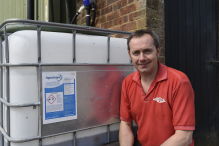Tackling hard water to protect herbicide performance
Martin Sweet can remember the day black-grass arrived on his farm. Little did he know that 20 years later it would be the bane of his farming life.
“It came in via a baling contractor. On the spot where the first bale was ejected up came a dense patch of black-grass. We didn’t know what it was at the time, but we certainly do now,” he says.
Over the years it has been steadily moved around the farm, principally through machinery carrying it between fields, and its influence has increased as the problem worsened.
“We do what we can to keep machines clean, but it’s a small seed and it gets into the deepest of places; sometimes, it’s just not practical to stop and clean machinery before moving fields,” he explains.
Farming 255 hectares on the Whittlesey Fen in north Cambridgeshire, Mr Sweet employs a rotation comprising sugar beet, peas, wheat and oilseed rape with small area sown to Chamomile for medicinal applications on behalf of a neighbour.
“With herbicide efficacy falling, the rotation has become an important part of my efforts to control all weeds. What began as a desire to better control black-grass has become standard practice,” he explains.
“We have relied on a limited number of herbicides for too long. Resistance to certain sulfonyl urea herbicides is widely reported and there is mounting evidence that a number of dims may also be affected,” he adds.
The seriousness of herbicide resistance came home to bite however, one day when he was walking a field of wheat.
“It crept upon me over the course of several seasons, but I began to notice the declining performance of cycloxydim. I then had the scary thought that if the same were to happen to glyphosate, then it would be the beginning of the end for arable crops on this farm,” he says.
This was the catalyst for change. Cereal varieties with a slow growth habit were dropped in favour of those with strong autumn vigour and a granular applicator added to the Cambridge rolls to enable more precise application of tri-allate.
The use of contract balers on this farm has also declined sharply. This is partly to reduce the opportunity for weed seeds to be introduced, but also because of a desire to incorporate more straw and support soil bacteria.
Use of the plough has also been retained to reduce the viability of seeds by burying them and bad patches are sprayed off before the weed sets seed.
“Sugar beet is the obvious crop to plough before as it spreads the seasonal workload. Research also indicates beet yields better in deep cultivated soils because root growth is less constrained. We have also returned to tractor hoeing in beet for added control,” he explains.
Time for change
To protect the performance of glyphosate however, he has adopted two tactics.
“First, don’t cut the application rate from what is advised for the weed burden; and second, don’t let its performance be impaired by hard water.”
Glyphosate is one of the more susceptible active ingredients affected by hard water and several manufacturers actively promote its used with a water conditioner to limit the effect cations have on its performance.
“Like many users my water is sourced from the mains and as with much of East Anglia our water is high in calcium carbonate, typically in excess of 300 mg/litre. This is not something I could responsibly leave unaddressed,” he explains.
Following a discussion with his agronomist Stuart Walsham of Frontier Agriculture, he began using AquaScope, a blended water conditioner containing a range of complexing agents, at an inclusion rate of 0.25% of water volume to nullify the effects of calcium and other salts.
“Before going ahead, I looked at its performance in trials to better understand its contribution across a range of herbicides. The uplift in efficacy was quite impressive and it was clear that it was supporting herbicide performance. We now use AquaScope treated water with almost everything, including fungicides.”
What made it easy to use in practice however, was Frontier’s supply of AquaScope in 1000L IBCs which removed the burden of cleaning and disposing of 5-litre containers.
The IBC facilitates pre-conditioning of water when filling a cold-water storage tank with a Dosatron metering unit. This unit is plumbed directly into the fresh water supply, complete with one-way valve and works directly from the water pressure. No power is required and it is easily installed.
The Dosatron units are supplied by Frontier and it can advise on their installation and use.
Frontier’s contracting sales manager at Holbeach, Stuart Maltby has been helping growers with AquaScope and the Dosatron units for some time. Interest in the system owes much to its ease-of-use, he says.
“There are many benefits to growers using AquaScope. Crucially, the water is conditioned before it enters the spray tank and comes into contact with any chemical, and the inclusion rate is both accurate and consistent.
“Additionally, AquaScope contains an acidifying agent that reduces the impact of alkaline hydrolysis. When AquaScope is mixed, the crop has an increased uptake rate of pesticide due to its properties maintaining the aqueous phase of the spray droplet. It also contains an advanced anti-foaming agent to maximise the speed of filling the tank,” he says.
